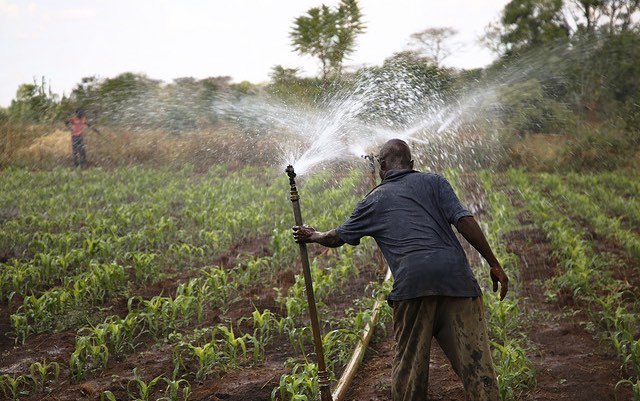Agricultural is a major player in the competition for the world’s finite water supplies: 70 percent of the world’s extracted freshwater goes to crop irrigation.
For this reason, technologies to maximize irrigation efficiency—increasing the “crop per drop” of irrigated water—are among the top tools promoted to improve food and nutrition security while protecting vulnerable natural resources.
The idea is that more efficient irrigation will save water and make it available for other users, such as industries, cities or the environment.
However, there is a paradox, according to Claudia Ringler, deputy director of IFPRI’s Environment and Production Technology Division: Increasing irrigation efficiency can fail to boost—and even reduce—the amount of water available for other purposes. In a recent article in Science, Ringler and her co-authors explain this paradox and offer policy recommendations to address it.
Evidence shows that more efficient water technologies reduce water losses at the field level as percolation into the ground and evaporation into the air are typically reduced—but some of these water flows were previously used elsewhere in the watershed. At the same time, while more efficient water technologies are likely to improve crop yields and quality, they are less likely to reduce water use in irrigation, as farmers act to utilize those additional flows—unless measures that complement the technology advancements are taken. In addition, improved water control itself provides incentives for farmers to increase water use: To improve meeting existing crop water demands, switch to more water-intensive crops, or expand irrigated areas. Such incentives are further enhanced when advanced technologies are provided as subsidies.
Efficient irrigation is still important and necessary, the article emphasizes. However, in the midst of a global water crisis, policy makers must combine this technological fix with additional measures to ensure that water is ultimately conserved and available:
- Transparent measurement and monitoring of water flows and balances to make clear “who gets what and where.” All inflows, water consumption, recoverable return flows, and nonrecoverable flows must be measured or estimated. This is crucial to support decision-making that is fair and in the public interest. The good news is that remote sensing technology makes this kind of estimation increasingly possible at a much lower cost and greater scale than previously available.
- Direct caps on water use or on the irrigated area are the only way to truly achieve decreases in water extractions and reductions in water consumption. Incentives, such as charging users for reductions in return flows or offering financial benefits for giving up water allocations, could generate real water savings.
- Consider risks and account for uncertainties when calculating water flows and evaluating the effects of irrigation efficiency. Better data quality and quantity, user-friendly software, and increased computing power can all be used to make better decisions about future water use in a context of uncertainty.
- Appraise the trade-offs of irrigation efficiency to see if the benefits of subsidizing it—such as increased food production and/or incremental taxes paid by irrigators—exceed the costs, including the costs of reduced return water flows.
- Consider the behavior of irrigators. Irrigation efficiency and water extractions do not occur in a vacuum: They vary by farmer, irrigation institutions, by land and soil characteristics, water access, crops grown, season, and weather conditions. Testing how irrigators’ actions change as irrigation efficiency increases can shed light on how these factors influence water consumption. Understanding irrigators’ behavior has the added benefit of helping policy makers identify effective incentives for them to farm productively while extracting less water.
As farmers around the world increase production to satisfy demand from a growing population, the global water crisis will only get worse. Simply increasing “crop per drop” irrigation efficiency will not solve this problem—and could make it worse. Ringler and her colleagues hope their practical, research-based recommendations can help both farmers and policy makers make real contributions to more effective water management.
Marcia MacNeil is an IFPRI Communications Specialist.







